
By Headspace
Where is your mind when you’re cooking? Is it busy planning tomorrow’s schedule as the knife moves closer and closer towards your fingers along the length of a carrot? Is the mind still wrapped up in some excitement from earlier in the day, replaying a conversation over and over again as you put the rice or pasta on to cook? When we are looking forward to the future or back to the past, then by definition we cannot be in the present.
Cooking provides a wonderful opportunity to be present, mindful and aware, as opposed to being distracted, stressed or overwhelmed. It's an opportunity to train the mind, to understand what it means to be in the here and now, with a healthy sense of appreciation, patience. It’s also an opportunity to get back in touch with the food that you eat.
So here are two short exercises in mindful cooking from the meditation experts at Headspace to help you find some "me time" in what is sometimes considered a monotonous task.
The two exercises are aimed to suit the different types of food you might be making. If it's an oven baked dish, for example, then you have nothing to do but sit back and remain alert to your senses as you gently focus on the breath. But, if you are boiling, grilling or frying then you’re going to need to remain somewhat active and involved, as you stir, shake, flip or fry.
Remember, to get the most from these exercises, it's a good idea to switch off your phone and remove any other potential distraction from the kitchen.
Slow Cooking (Little To Do)
1. Placing the food in the oven, grill or casserole, set the heat, the timer, and make sure there is nothing else you need to think about.
2. Sit in a chair not too far from the oven and relax into it. You have nothing to do but to stay alert to the changing sounds, smells, sensations and thoughts as you gently focus your attention on the breath. Try it just for a few minutes at a time to begin with, perhaps returning to the kitchen every 10–15 minutes or so to repeat the exercise and notice the changes.
3. There’s no need to worry if your mind wanders off while you’re doing this, but as soon as you realize it has, just bring your attention back to the breath. Then shift your attention to the other senses, such as the smell, the increasingly warm temperature in the room or the rumbling in your stomach as the digestive juices begin to flow in preparation for the meal.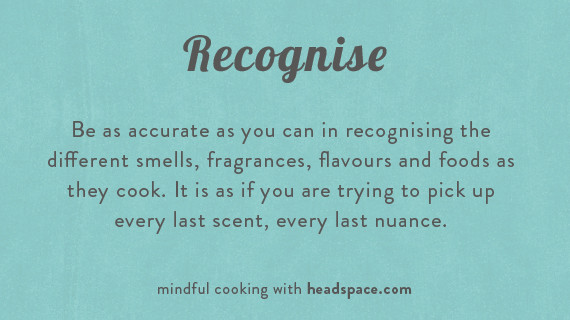
4. Be as accurate as you can in recognizing the different smells, fragrances, flavors and foods as they cook. Imagine you are trying to pick up every last scent, every last nuance. It's surprising just how much you can recognize when you really put your mind to it.
5. As you become aware of these things, notice where your mind wants to travel. Does it drift off to memories past, perhaps associating the smells with previous meals? Or does it race ahead to the future, perhaps imagining what the food is going to taste like? This doesn’t require any analysis or thinking, it is simply a matter of being aware.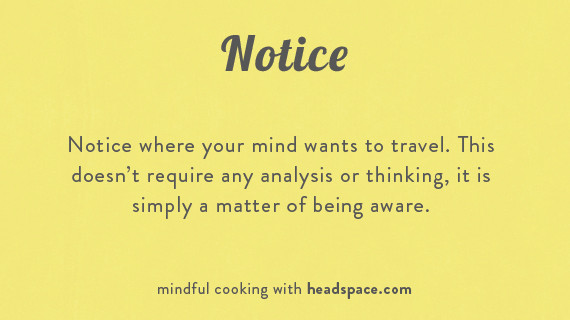
Fast Cooking (Lots To Do)
1. Begin from the very first moment you place the water on the heat, or pour the oil in the pan. Listen to the sounds, the smells and the sensations that the heat immediately gives rise to.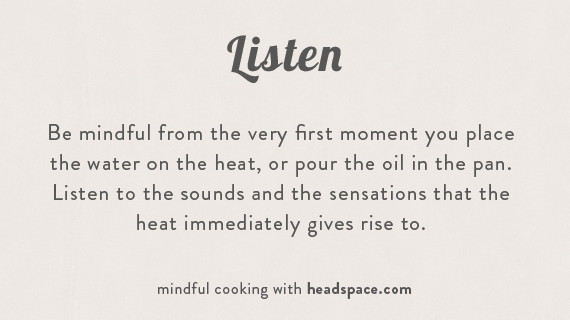
2. As you begin to cook the various foods, notice how the addition of each new ingredient affects the overall fragrance of the dish. Allow yourself to be 100 percent present with the different senses, rather than being lost in thought. Each time the mind wanders, just gently bring the attention back to these sounds and smells.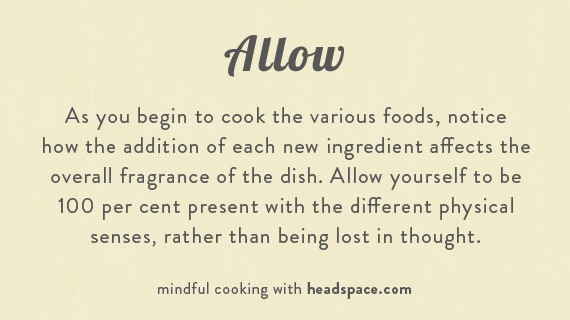
3. Try to be aware of how your mood and your thinking changes throughout the cooking process. Do you find the heat oppressive? Do you find yourself getting anxious trying to keep all the different things going at once, or confident and in control? Don’t try and change any of these things for now –- simply building up a picture is enough.
4. As you observe the mind, use the physical senses as a safe place to come back to when you feel the emotions running off. For example, rather than feeling anxious about feeling anxious, come back to the smell of the food. Instead of getting increasingly frustrated at feeling frustrated, bring your attention back to the sounds of the food cooking.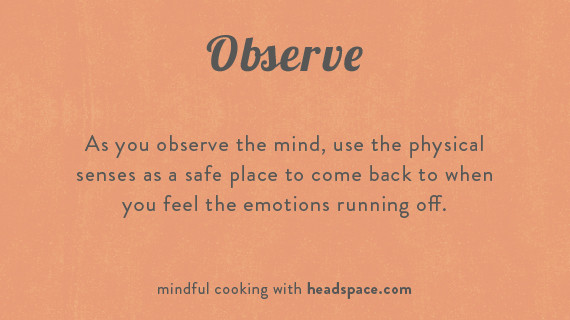
5. Throughout this exercise, notice how your mind behaves. Is it a mind that’s comfortable being in the moment? Or does it tend to race off to plan things for the future, or drift off to memories of the past? Being aware of the thoughts in this way will help you to get much better at the exercise, which, for most people, means enjoying a more serene experience in the kitchen.
Want more tips on how to make meditation part of your day? Headspace is meditation made simple, accessible and relevant to your everyday life. Sign up for the free Take10 program to get the basics just right with guided audio programs and support to get your Headspace, anytime, anywhere on the Headspace app.
For more on mindfulness, click here.
